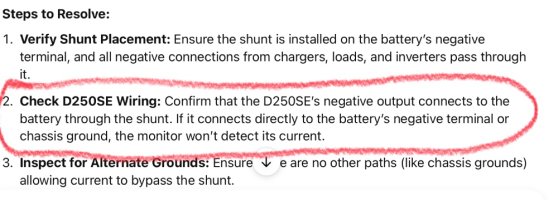You are using an out of date browser. It may not display this or other websites correctly.
You should upgrade or use an alternative browser.
You should upgrade or use an alternative browser.
CTEK d250se not charging from alternator supply
- Thread starter boileroo
- Start date
If you are getting charge from the CTEK when you have solar input then we can assume (I think) that the charger output of the CTEK is fine as is the wiring downstream to the leisure battery,
If you are seeing the same behaviour on 2 units then that leaves the following I think:
I still feel if both units are behaving in the same odd way the issue lies somewhere in the vehicle wiring, most likely that it's got the battery type wrong.
If you had a DC clamp multimeter it would also be interesting to see what the current flowing in the CTEK input and output cables was.
I'm tempted to say try and temporarily use a jump lead to connect the +12v CTEK input directly to the start +12v and run the engine under conditions charging should be happening having disconnected (and made safe!) the cable that is there - that might show any structural issue with the existing supply to the CTEK. Having said that if that was a high resistance connection for any reason I'd expect the voltage you were measuring at the CTEK input to sag down quickly every time it tried to charge (and for the error lights to come on)
If you are seeing the same behaviour on 2 units then that leaves the following I think:
- There is something restricting the power available on the input - but you've sorted out a bad earth so this seems less likely
- Both CTEK devices have the same fault (possibly on the input) - this seems unlikely, unless they've both been damaged by the same as yet undiscovered fault in your vehicle
- The CTEK is choosing not to charge based on an issue to do with the options wires we've not traced - but the display on the CTEK seems to suggest it has made an active decision to charge, I'd expect no amber lights if it had decided to shut down
I still feel if both units are behaving in the same odd way the issue lies somewhere in the vehicle wiring, most likely that it's got the battery type wrong.
If you had a DC clamp multimeter it would also be interesting to see what the current flowing in the CTEK input and output cables was.
I'm tempted to say try and temporarily use a jump lead to connect the +12v CTEK input directly to the start +12v and run the engine under conditions charging should be happening having disconnected (and made safe!) the cable that is there - that might show any structural issue with the existing supply to the CTEK. Having said that if that was a high resistance connection for any reason I'd expect the voltage you were measuring at the CTEK input to sag down quickly every time it tried to charge (and for the error lights to come on)
i have a spare 6m 4 AGW wire that I can crimp and run direct from the starter battery positive to the ctek input but the same is happening at the moment but through a breaker. The voltage is adequate at the moment BUT, good to rule it out and check.If you are getting charge from the CTEK when you have solar input then we can assume (I think) that the charger output of the CTEK is fine as is the wiring downstream to the leisure battery,
If you are seeing the same behaviour on 2 units then that leaves the following I think:
- There is something restricting the power available on the input - but you've sorted out a bad earth so this seems less likely
- Both CTEK devices have the same fault (possibly on the input) - this seems unlikely, unless they've both been damaged by the same as yet undiscovered fault in your vehicle
- The CTEK is choosing not to charge based on an issue to do with the options wires we've not traced - but the display on the CTEK seems to suggest it has made an active decision to charge, I'd expect no amber lights if it had decided to shut down
I still feel if both units are behaving in the same odd way the issue lies somewhere in the vehicle wiring, most likely that it's got the battery type wrong.
If you had a DC clamp multimeter it would also be interesting to see what the current flowing in the CTEK input and output cables was.
I'm tempted to say try and temporarily use a jump lead to connect the +12v CTEK input directly to the start +12v and run the engine under conditions charging should be happening having disconnected (and made safe!) the cable that is there - that might show any structural issue with the existing supply to the CTEK. Having said that if that was a high resistance connection for any reason I'd expect the voltage you were measuring at the CTEK input to sag down quickly every time it tried to charge (and for the error lights to come on)
The lights have always looked good and i’ve never seen even a flicker from the red fault light.
The battery is a eco-worthy 100ah & 12.8v is written on it with no explanation of why 12.8?
It’s a pity that there is not a manual way to change battery type.

As @jimc91 says some pictures of your actual install are really what is needed here as that is likely where the issue lies
( The "nominal" voltage of a LiFePo cell is 3.2v so 4 x 3.2 = 12.8 - so that battery is made of 4 LiFePo cells. Contrast that to a traditional battery where a lead acid cell nominal voltage is 2.0v and a battery is made up 6 x 2.0 = 12.0 so six cells )
( The "nominal" voltage of a LiFePo cell is 3.2v so 4 x 3.2 = 12.8 - so that battery is made of 4 LiFePo cells. Contrast that to a traditional battery where a lead acid cell nominal voltage is 2.0v and a battery is made up 6 x 2.0 = 12.0 so six cells )
I will send tomorrowAs @jimc91 says some pictures of your actual install are really what is needed here as that is likely where the issue lies
( The "nominal" voltage of a LiFePo cell is 3.2v so 4 x 3.2 = 12.8 - so that battery is made of 4 LiFePo cells. Contrast that to a traditional battery where a lead acid cell nominal voltage is 2.0v and a battery is made up 6 x 2.0 = 12.0 so six cells )
Just to double check a couple things, can you confirm both batteries are grounded to the vehicle chassis and also that there is a connection from the ctek negative terminal to the vehicle chassis or confirmed 0v, as either of these missing would make a missing reference (0V) voltage for the unit to measure against ?
Again photos would help to clarify this
Again photos would help to clarify this
Confirmed both batteries are grounded to the vehicles chassis but in different places.
The negative cable from the ctek is connected onto the leisure battery negative.
Here’s some photos from this morning. I have completely isolated the shunt from the system and am presently running the battery down with an applience on the inverter.
I have the options wires connected to a connection block as they have been on and off so many times there is a 14.4v indication on the red options cable when the car starts and the black is the top connection on the positive leisure battery post.
1. Starter battery.
2. Starter battery 30 amp breaker good voltage on the ctek side.
3. Options cables connection piece.
4. Leisure battery negative connection, one cable to the chassis ground, one to the inverter through 200 amp breaker and one from the negative cteck out.
5. 30 amp breaker between the ctek and leisure battery
6. Whole system with the shunt disconnected, the cables in and out of the top left breaker are both positive there is a piece of black shrink wrap on one cable - disregard it.
7. Leisure battery positive with the black option cable on top.
8. Leisure chassis earthing point, cleaned up underneath with a dremel to shiny metal and voltage is good.
As soon as the battery is run down I will wait for it to stabilise then start the engine and see if it’s taking a charge.




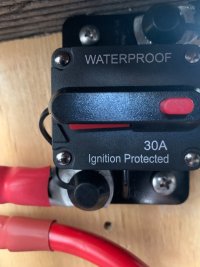
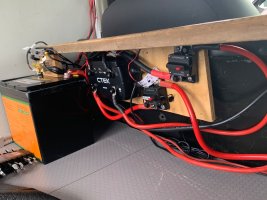


The negative cable from the ctek is connected onto the leisure battery negative.
Here’s some photos from this morning. I have completely isolated the shunt from the system and am presently running the battery down with an applience on the inverter.
I have the options wires connected to a connection block as they have been on and off so many times there is a 14.4v indication on the red options cable when the car starts and the black is the top connection on the positive leisure battery post.
1. Starter battery.
2. Starter battery 30 amp breaker good voltage on the ctek side.
3. Options cables connection piece.
4. Leisure battery negative connection, one cable to the chassis ground, one to the inverter through 200 amp breaker and one from the negative cteck out.
5. 30 amp breaker between the ctek and leisure battery
6. Whole system with the shunt disconnected, the cables in and out of the top left breaker are both positive there is a piece of black shrink wrap on one cable - disregard it.
7. Leisure battery positive with the black option cable on top.
8. Leisure chassis earthing point, cleaned up underneath with a dremel to shiny metal and voltage is good.
As soon as the battery is run down I will wait for it to stabilise then start the engine and see if it’s taking a charge.








Last edited:
It may just be the angle of the photo but the cable to the ctek + out doesn't look like its making good contact, there looks like a gap behind it. I would alos check continuity on the black cable you have used to extend the black signal wire just in case there is a break in it.
The shunt is totally disconnected in the following pictures.
Ok, when the last amber led lights up to indicate charging I hear the engine tone change so something is happening!
Zero light flickering, everything is solid and steady.
The difference between resting state and ”charging” is very small, what whould the multimeter read at the leisure battery if everything is working correctly?
1. Leisure battery run down and resting.
2. Engine running and reading on the ctek side of the starter battery breaker.
3. Reading with engine running at the leisure battery.
4. Ctek positive out and negative reading with the engine running.
5. Ctek power input and negative with the engine running.


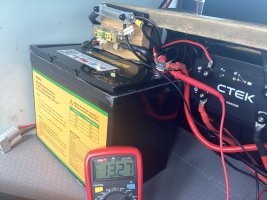
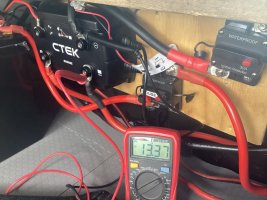

Ok, when the last amber led lights up to indicate charging I hear the engine tone change so something is happening!
Zero light flickering, everything is solid and steady.
The difference between resting state and ”charging” is very small, what whould the multimeter read at the leisure battery if everything is working correctly?
1. Leisure battery run down and resting.
2. Engine running and reading on the ctek side of the starter battery breaker.
3. Reading with engine running at the leisure battery.
4. Ctek positive out and negative reading with the engine running.
5. Ctek power input and negative with the engine running.





I took the car for a 30 minute run, at the start the battery had been resting for over an hour and it read 13.13v when I came back I let it stand for over an hour again and checked.
It now shows 13.24v, so seems to be charging!! is this a normal rate of charge for a LiFePO4?
Maybe there was something with the shunt

It now shows 13.24v, so seems to be charging!! is this a normal rate of charge for a LiFePO4?
Maybe there was something with the shunt
Yep that would definitely stop you detecting the currentI found this on the Renogy shunt site, oops! I may have found the problem. I had the Ctek negative connected to the negative battery terminal.
View attachment 282693
I know, I was wondering if an old one without and a new one with bluetooth wired in parallel would work?
Just charging my battery to 100% on the mains before I reset the monitor to 100%.
Seems like it was my fault all ofthe time


Good to remember though for any other future idiot such as me


Just charging my battery to 100% on the mains before I reset the monitor to 100%.
Seems like it was my fault all ofthe time
Good to remember though for any other future idiot such as me
Last edited:
At least we tracked it down, often when you find the root cause it seems obvious but at the start not so much.
The advantage you had is that having 2 chargers behave the same way it was much less likely to be a charger fault and out somewhere in the wiring.
Generally you should never bank anything other than identical batteries, ideally bought at the same time. That's even more important with LiFePo batteries as they are not truly directly exposed to the terminals but via a BMS - if the BMS in each battery doesn't behave identically very odd things can happen.
The advantage you had is that having 2 chargers behave the same way it was much less likely to be a charger fault and out somewhere in the wiring.
Generally you should never bank anything other than identical batteries, ideally bought at the same time. That's even more important with LiFePo batteries as they are not truly directly exposed to the terminals but via a BMS - if the BMS in each battery doesn't behave identically very odd things can happen.
Similar threads
- Replies
- 9
- Views
- 387
- Replies
- 2
- Views
- 178
- Replies
- 2
- Views
- 587
- Replies
- 5
- Views
- 465

